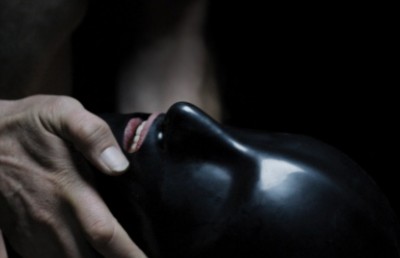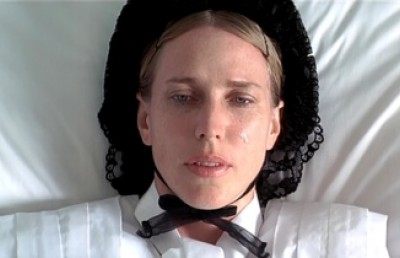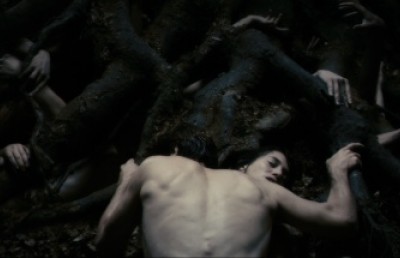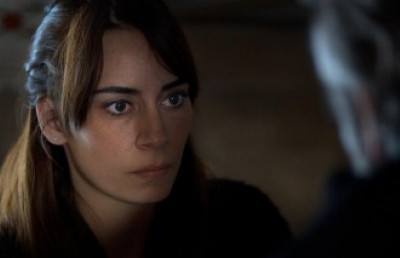Todd Haynes, I’m Not There and the Postmodern Biopic
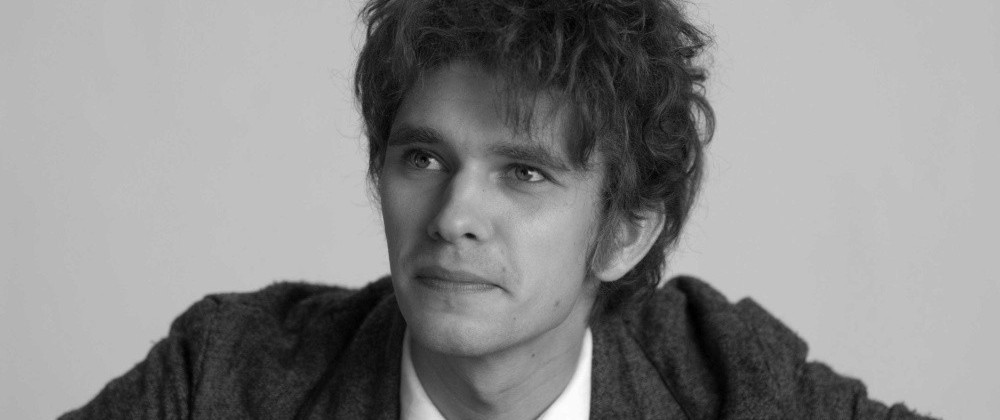
In I’m Not There (2007), director and co-writer Todd Haynes presents a tightly coded web of interwoven narratives, themes and styles that serve as a postmodern deconstruction of the Hollywood biopic. Among the ideas associated with postmodernism that Haynes uses in this film are appropriation and collage, the destabilization of identity and a story structure influenced by a non-linear conception of history that undermines a cinematic genre’s traditional form. Most importantly, by making a film that consciously engages with and reflects on the legend of Bob Dylan rather than his life, I’m Not There is an example of remediation, a version of reality based on reworking an already existing version of reality. This self-conscious act of remediation, in turn, serves to expose the hollowness and dishonesty at the heart of Hollywood biography.
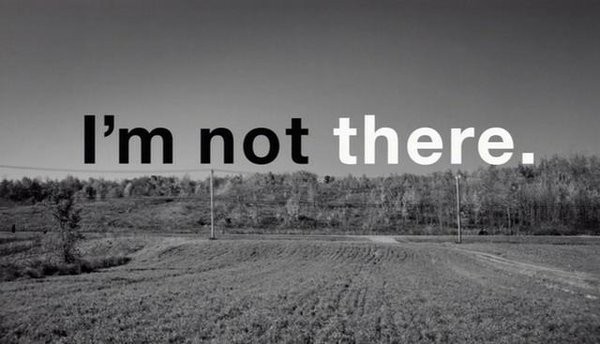
I’m Not There
A common element in postmodern work is the strategy of appropriation. Jean-François Lyotard argues that a characteristic of postmodernism is “a sort of bricolage – the high frequency of quotations of elements from previous styles or periods” (1613). This typically involves taking existing work, either through quotation or reference or reuse of specific material, and creating something new by placing it in a different context, often through juxtaposing it against other work similarly removed from its original context. In effect, this functions in a manner similar to Eisensteinian montage, that the juxtaposition of two images through editing will create meaning that is not necessarily inherent in either of the original images. The original work may retain its meaning, but this new context comments on that meaning and the interaction with the new context can simultaneously create something altogether new. This strategy also serves to highlight that the idea of “original work” is a contested one. As Tony Barrett writes, “By appropriating or borrowing or plagiarizing or stealing, postmodernists remind us that the notion of originality is absent in most traditions of art” (25-26). These ideas find an echo in a script that consists largely of a dense patchwork of allusions and references, much of it direct quotations from other films, lines from songs Dylan wrote and excerpts from interviews he has given over the years.

Bound for Glory (1976)]

Idyllic countryside with train in I’m Not There
The film’s primary means of appropriation is in its series of cinematic styles, in which each of the various versions of Dylan are filmed in a way that mimics a previously existing style. For the story of Woody (Marcus Carl Franklin), Haynes cites examples of what he calls “leftist studio filmmaking,” such as A Face in the Crowd (1957, Elia Kazan) and Bound for Glory (1976, Hal Ashby) (Macdonald 64). While this is undeniable, as Woody’s dialogue includes lines lifted from A Face in the Crowd and the greens, yellows and reds in the lovingly photographed landscape evoke the celebrated pastoral tone of Haskell Wexler’s work on Bound for Glory, not coincidentally a biopic of Woody Guthrie, Haynes’ referencing is much more extensive. Beyond the naming of the young Dylan character “Woody” being an obvious nod to the “real” young Dylan’s admiration for Guthrie, the extensive quotations go beyond the films Haynes cites to include mainstream Hollywood films which grapple with the issues of authenticity and originality that is foregrounded by the appropriation strategy. For example, both the friendly and unfriendly hoboes Woody meets on the boxcars recall the hoboes of Sullivan’s Travels (1941, Preston Sturges), both the helpful friendly ones from the early part of the film and the later, unfriendly hoboes who ultimately attack the hapless director seeking authenticity through contact with them, as Woody does here, and as the real Woody Guthrie had done in his time (and as the young Bob Dylan claimed to have done as well). A nightmare sequence visually quotes from Meet John Doe (1941, Frank Capra), a film about a hobo who is built into a hero by scheming politicians and then unmasked by them when he tries to rebel, a plot point that finds an echo here. In fact, the climax of A Face in the Crowd also involves an unmasking, as does each segment of I’m Not There. The later sequence where Woody is briefly adopted by a liberal white family is shot in the style of Douglas Sirk, and refers not only to Sirk’s lush suburban films of the 1950s, but also to Haynes’ own Far from Heaven (2002), which also appropriated Sirk’s film language for subversive purposes.
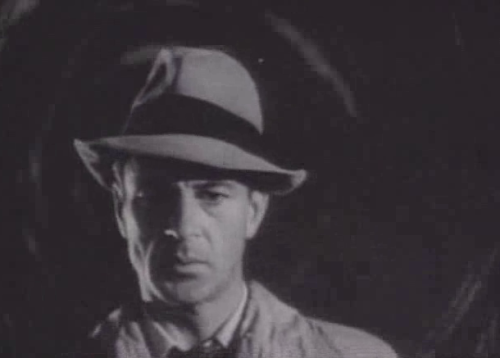
Gary Cooper’s nightmare in Meet John Doe (1941)
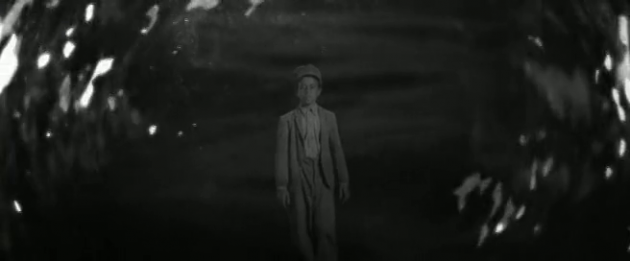
Woody’s nightmare in I’m Not There
Beyond the film style, there is the narrative itself, which in classic biopic fashion presents childhood moments which are used to “explain” the subject, a famous mainstream Hollywood example being the accidental childhood death of Johnny Cash’s brother providing the psychological motivation for, among other things, his later problems with drugs in Walk the Line (2005, James Mangold). In I’m Not There, the corresponding childhood incident has a motherly woman telling Woody to stop singing about the 1930s and “live in his own time.” The artificial and contrived nature of the scene, which of course has no known correspondence to anything that happened to Dylan as a child, is precisely the point. It is Haynes’ way of using pastiche and appropriation to critique traditional Hollywood formula and expressing his opinion that the biopic is “a deceitful genre” (Porton 20).
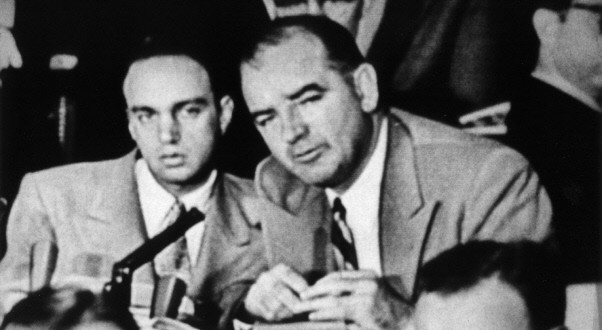
Roy Cohn and Joe McCarthy interrogate a witness in Point of Order (1964)
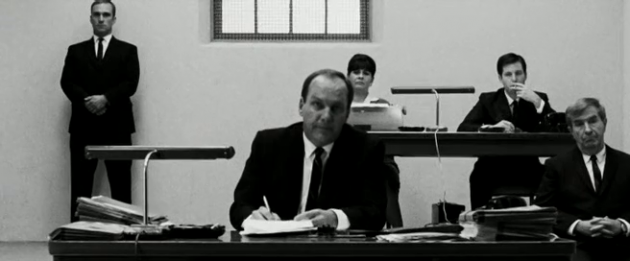
The investigation committee in I’m Not There
The other sections of the narrative are also appropriations of film styles. Haynes describes the Arthur (Ben Wishaw) sequences as “experimental minimalism” (Macdonald 64), but staging these scenes as an inquiry and using an overexposed look reminiscent of 1950s television kinescopes also evokes Emile de Antonio’s classic documentary Point of Order (1964), about the unmasking of Senator Joseph McCarthy. The first part of the Jack Rollins (Christian Bale) story is largely a pastiche of Martin Scorsese’s Bob Dylan documentary No Direction Home (2005), which in turn borrowed extensive footage from the earlier documentaries Festival (1967, Murray Lerner), Dont Look Back (1967, D.A. Pennebaker) and Eat the Document (1972, Bob Dylan and D.A. Pennebaker). The Pennebaker documentaries are also referenced in the section featuring Jude (Cate Blanchett), but the style here is lifted from 1960s European art cinema. That is, the incidents shown were originally presented on film in the style of cinéma vérité, but now reappear here as if restaged by Fellini or Bergman. The film most often referenced is Fellini’s 8 ½ (1963), notably the visual recreations involved in the car in the tunnel, the garden party and Jude floating like a balloon, along with the crisp black and white photography, but there are also several nods to Ingmar Bergman’s Persona (1967), notably the corpse on the slab at the beginning, the monk setting himself on fire on TV and the tarantula crawling across the white screen. Other films referenced in these sequences include John Schlesinger’s Darling (1965) (the “swinging London” nightclub) and Richard Lester’s A Hard Day’s Night (1964), with the Beatles making an appropriately comic cameo appearance before exiting, chased by screaming fans.

Garden party in 8 ½ (1963)
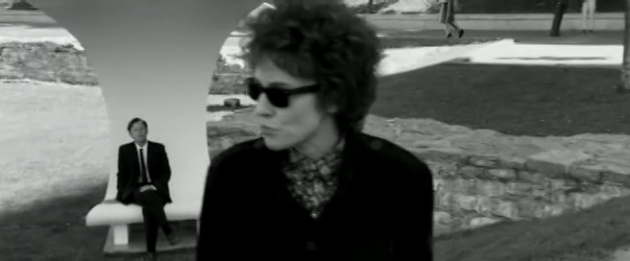
Garden party in I’m Not There

8 1/2
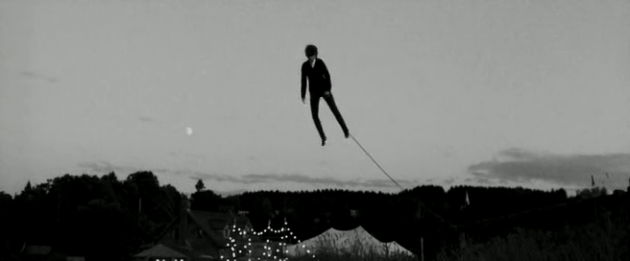
I’m Not There
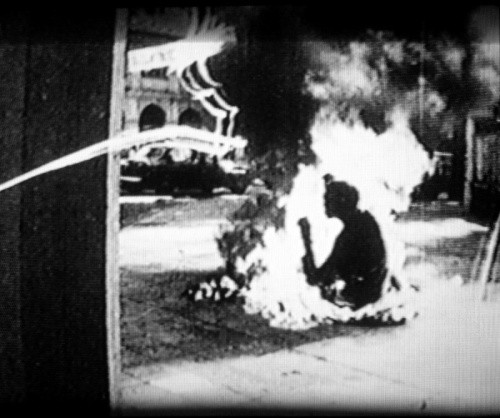
Monk on fire in Persona (1966)
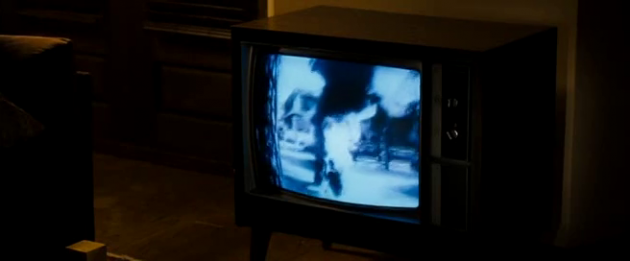
I’m Not There
The story of Robbie (Heath Ledger) is told in the muted colour of Jean-Luc Godard’s mid-1960s films, particularly 2 ou 3 choses que je sais d’elle (1967), which, along with Masculin Féminin (1966), serve as sources for Godardian voiceover monologues (at the premiere of Robbie’s film and in Claire’s letter, respectively). Michael G. Smith also notes that the camera circling the face of the statue in the “Visions of Johanna” sequence is “identical to several shots” in Godard’s Le mépris (1963) (Smith). This section also uses narrative devices associated with this period of Godard’s work, such as inter-titles, voiceover narration, unmotivated camera movement, unbalanced framing, characters directly addressing the camera or reading extensive quotes (notably a poem by Rimbaud, who is repeatedly referenced throughout the film) and disorienting jump cuts. A good example of this disorienting editing is a scene in a café where mirrors are used to confuse the audience and the actor speaking is rarely the subject of his or her own shot. And while Godard is the keynote, Haynes also finds time for nods to L’année dernière à Marienbad (1961, Alain Resnais) and Petulia (1968, Richard Lester).
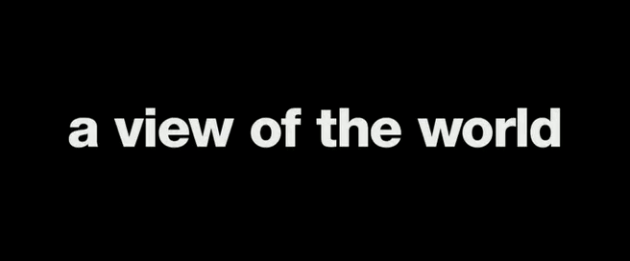
Godardian inter-tile in I’m Not There
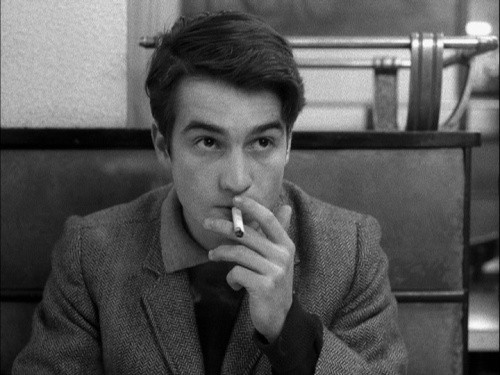
Jean-Pierre Léaud in Masculin-féminin (1966)
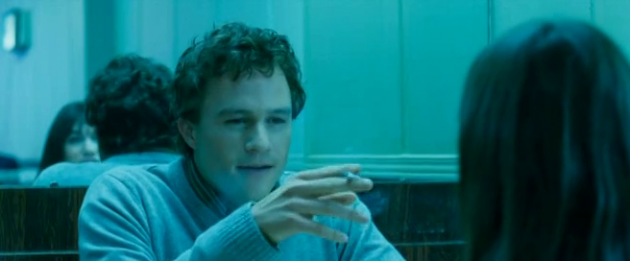
Robbie in I’m Not There
The Billy (Richard Gere) segment employs the long lenses, frequent zooms, freeze frames and saturated colours associated with the “hippy westerns” of the late 1960s and early 70s such as McCabe and Mrs. Miller (1971, Robert Altman) and Pat Garrett and Billy the Kid (1973, Sam Peckinpah), which Dylan acted in, offering another level of referencing. Beyond this, the art direction also borrows heavily from the album cover of Dylan’s Basement Tapes (1975) (Danks 26). Finally, the stark look of the scenes featuring Pastor John (Christian Bale again, playing Jack twenty years later) is lifted from the gospel music documentary Say Amen, Somebody (1982, George T. Nierenberg) (Silberg 50). These appropriations are not pastiche for their own sake. Beyond the ways in which they are used to comment on Dylan (as in the sexism present in some nouvelle vague films finding a correspondence in Dylan’s songs and life), they also critique and illuminate the film’s form. As James Morrison writes about Far from Heaven, this strategy of appropriation is used to make us aware that what “we are seeing . . . has been filtered through cultural references rather than being reconstructed in some ‘direct’ way” (4). Haynes is telling his audience that there is no neutral way of telling a story; to make a film, filmmakers make choices informed by the cultural context in which the film is made.
Also central to the film’s narrative is the concept of the fragmentation of identity, as well as a postmodernist skepticism about the goal of recreating an objective truth that underlies the traditional biopic. As John Hill argues, “Postmodern theory . . . lays stress on the heterogeneity and fragmented character of social and cultural ‘realities’ and identifies as well the impossibility of any unified, or comprehensive, account of them” (97). Identity is at the heart of I’m Not There, as it can be read as a series of struggles between an artist and the public and media over who gets to define the artist, each climaxing with an unmasking where the subject-artist loses control of his identity and is forced to move on. Examples of this are the telephone call that reveals Woody to be a fugitive from a juvenile prison, the news story revealing Jude’s real name and social class, and Billy removing his mask at the order of Pat Garrett (Bruce Greenwood). A different, but related type of unmasking, is presented in the scenes where Claire (Charlotte Gainsbourg) becomes aware of Robbie’s infidelities and sexism. This focus on masks is very appropriate to Dylan’s story, as he has been defined over his long career by constantly changing personas and his self-conscious acknowledgements of this. As early as 1964, he told a Halloween concert audience that he had his “Bob Dylan mask” on (Dylan), while he wore whiteface makeup (a mask of sorts, which is shared by the band’s singer in the “Billy” segment) on his 1975 Rolling Thunder tour, and had Ronnie Hawkins play a character named “Bob Dylan” in Renaldo and Clara (1978, Bob Dylan), with Dylan himself playing Renaldo. There is also the title of Dylan’s more recent film Masked and Anonymous (2003), which signals his continuing interest in the idea and perhaps explains his willingness to allow Haynes to make I’m Not There.
The most obvious of Haynes’ strategies relating to the fragmentation of identity is in his casting of six actors to play seven different aspects of his subject, while an eighth version shows up at the very end through the inclusion of concert footage of the real Dylan (if, by the end of the film, the viewer still believes there is such a thing). The casting is more than a stunt; it is used to provide a running commentary on Dylan. For example, the use of an 11-year old African American as Woody points to Dylan’s own appropriation of Woody Guthrie’s legend in the fictional stories about his background he told at the beginning of his career, as well as the search for authenticity in and appropriation of African American music practiced by Dylan and countless other white musicians before and since. Similarly, the casting of Cate Blanchett as the mid-1960s “electric” Dylan highlights the androgyny of that incarnation and is an example of how Haynes uses postmodernist ideas to undermine and “queer” a traditional genre. This version of Dylan is not only given a sexually indeterminate name (Jude), but is twice called “Judy” (a female name) as well as a “cocksucker.” The scene where Jude meets Allen Ginsberg (David Cross) is playfully flirtatious, and is followed by Jude’s sidekick suggestively saying “He’ll give it to you, all right.” Finally, the “Ballad of a Thin Man” sequence, where the reporter (Bruce Greenwood again) investigates Jude’s past, is filled with gay iconography. This includes a shot of a fly being unzipped, a bath house scene and a brief flash of Greenwood naked, and is accompanied by one of the few Dylan songs which can be read to contain gay allusions (the “sword swallower” who kneels, and then “clicks his high heels”). This deliberately artificial casting of multiple Dylans recalls Haynes’ use of a Barbie doll to portray Karen Carpenter in Superstar (1988) and the African American actor Dennis Haysbert in Far from Heaven to play the type of role Rock Hudson played several times for Douglas Sirk. As Haynes argues, “you’re forced to think about why that choice is being made – as opposed to the traditional biopic where you’re not allowed to think about these choices because that would ruin the entire illusion” (Porton 20). By deliberately puncturing the illusion created by the accurate mimicry offered in performances such as that of Jamie Foxx in Ray (2004, Taylor Hackford) or Ben Kingsley in Gandhi (1982, Richard Attenborough), Haynes is able to go beyond surface impressions and engage with what may lie beyond them.
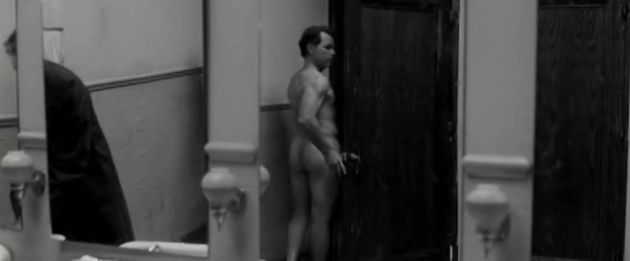
Bruce Greenwood as naked reporter
Another characteristic of postmodernism is the rejection of linear conceptions of history and traditional narrative forms. The storyline of I’m Not There is deliberately fractured and while the separate stories seem to be complete within themselves, they continually leak into each other as echoes and repetitions of events run through the film. There are motorcycle crashes at the beginning and the end. The film also starts with Woody hopping a train and finishes with Billy hopping a train (Smith). The “documentary” about Jack the early 1960s folksinger is continued later in the Pastor John segment. The focus in the first half on Robbie and Claire as young lovers shifts to their failing relationship in the second half. This is particularly expressed in how the two sex scenes are used to chart the evolution of their relationship. The central Jude section is bracketed by two concerts which highlight the artist-audience conflict, one in which he machine guns his fans and the second where he is chased off the stage by an angry mob shouting “Judas.” Despite the constant intercutting, Michael G. Smith has ingeniously worked out that the chronological story is structured in this way: 1. Woody 2. Jack Rollins 3. Robbie’s marriage 4. Jude 5. Robbie’s divorce 6. Pastor John 7. Billy (Smith). However, this is complicated by the use of extended flashbacks in the Woody and Robbie segments, as well as recurring hints that the story is actually circular. One aspect of the film’s non-linearity is the placing of Billy’s story at the end, even though the music associated with this period (songs from the Basement Tapes album, recorded in 1967) comes before that associated with Robbie’s divorce (Blood on the Tracks, from 1975) and Pastor John (Dylan’s “born again” period of the late 1970s and early 80s). The reason for this is that to the extent the film has a story arc, it is in the evolution from the compulsive liar Woody (who the narrator labels a “fake”) to Billy, an iconic outlaw inhabiting what Smith describes as “a mystical folk music world of his own design,” mirroring Dylan’s own trajectory from Woody Guthrie imitator to his current status of touchstone of authenticity and artistic integrity (Smith). This is in itself ironic, since this authenticity was gained through the process of picking up and discarding a series of personas. It also echoes Haynes’ comment, citing Greil Marcus, that “the origins of American folklore . . . [is] a series of masks, of adopting guises and personas, not as the validation of some authentic core about ‘who we are’” (Feinstein 38).
I’m Not There ends with Billy finding Woody’s guitar in the boxcar, showing Woody Guthrie’s words “This machine kills fascists,” previously clear, are now faded. Does this mean the film has a a circular structure, with Billy being reborn as Woody? In support of this, Woody’s story only properly begins after a shot of Billy waking up and opening his eyes. Similarly, Woody’s escape from a juvenile detention centre could be a reference to Billy’s prison break. On the other hand, there are also suggestions the stories are happening simultaneously despite the variety of periods. There are several shots of Billy, Woody and Claire waking up, as if each story is another character’s dream, and Claire actually appears at the end of Woody’s nightmare where he is swallowed by a whale. This blurring of barriers between separate stories is characteristic of what Marcia Landy describes in Haynes’ films as a constant “daring exercise in experimenting with narrative forms and styles that self-consciously address and enact the dilemma and possibility of storytelling in the contemporary world” (7). It is Haynes’ dealing with the postmodern sense that both classic and modernist narrative devices have become exhausted and something new is needed.
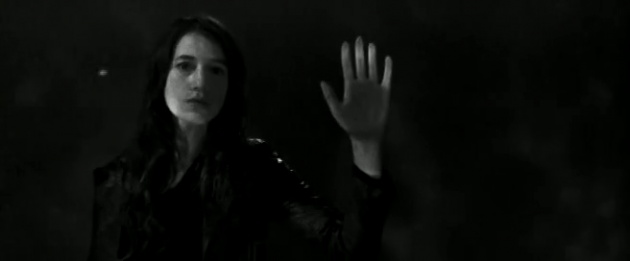
Claire enters Woody’s dream
One of the most artistically exhausted, even if perennially popular, classic film genres is the biopic. While Haynes blends fact and fiction in the manner of the traditional biopic, he argues that in his film “the difference is that you’re in on the joke, you’re invited to laugh at this process along with me . . . it’s a creative choice to make a point.” (Porton 20) The point being that the genre’s tendency to “nail down, interpret and smoothly narrativise their subject’s career” (Danks 26) is inherently false, as all we really can claim to “know” about the subject is what has already been produced in one form of media or another. This dovetails with the postmodern idea, associated with Jean Baudrillard, that the modern world’s primary reality can be found in its images and signs and that “we now live . . . in a world of simulations, or hyperreality, which has no reality beyond itself” (Hill 98). Therefore, biopics are “unable to re-create a ‘real’ past but only a simulation based upon pre-existing representations and styles” (Hill 101). As Penny Spirou writes, “Haynes is not focused on the actual Dylan (or attempts to reveal his identity); he is primarily concerned with the public/media memory of the popular musician and re-packages this memory” (118). In light of this, it seems natural that Haynes would not make a film about the life of Bob Dylan, but instead perform a conscious act of remediation by taking the existing legends about Bob Dylan (“pre-existing simulations”) and reimagine them in the context of the time in which he made the film. Like Woody, he decides to avoid nostalgia and make art “in his own time.”
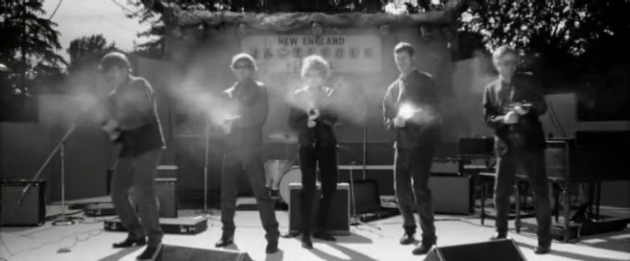
Todd Haynes reimagines legendary Newport concert
This remediation is inherent in the reimagining of Dylan as an African American child or as a sexually ambiguous adult to pinpoint a truth (but definitely not the truth) about him. But this remediation can also be seen in the film’s treatment of the Dylan legend. The two concerts that are the focal points of the Jude segment show alternate approaches and “rely more clearly on legend than existing and widely circulated documentation” (Danks 26). For the famous Newport concert where Dylan “went electric,” Haynes is content, in the manner of John Ford, to print the legend. This is a strong contrast to Martin Scorsese’s approach in No Direction Home, where “the account of Dylan’s 1965 Newport performance is positively Rashomon_-esque in comparison” (Danks 26). On the other hand, the Manchester concert where an audience member shouts “Judas” is completely rewritten. This event is so central to the Dylan legend that it provides the climax to _No Direction Home, where Dylan angrily answers the cry of “Judas” with a defiant command to his backing band to “play fucking loud.” Regardless of what actually happened (it is, naturally, contested), it is an iconic moment in popular culture, with an artist refusing to concede an inch to his public. In I’m Not There, however, his challenge to the crowd is answered by their overrunning the stage and chasing him away. In the contest between artist and audience over control of identity, Haynes seems to be suggesting that ultimate control rests in the person telling the story, which will inevitably be rewritten again in the future.
There is a further complication to Haynes’ presentation of the conflict between artist and audience. While the critics of Dylan’s abandonment of acoustic folk music for rock’n’roll are treated with predictable sarcasm, to the inevitable accompaniment of “Positively 4th Street,” there is an unexpected sympathy for the critics. The bereft fans who complain about Jude’s changing in the Newport sequence find an echo in the friend of Robbie’s who responds to a display of boorish sexism with the charge that Robbie has changed, and very much for the worse. Similarly, the scene where Jude is chased off the stage by enraged British folkies is revisited in the Billy segment where the angry, beleaguered common folk rush the stage where Pat Garrett and his murderous cronies are holding forth. In both cases, the initial presentation directs audience sympathy toward the defiant artist, but the later revisiting is intended to provide a retrospective questioning and complication of the earlier events. There is no event that cannot be challenged and re-evaluated by later events.
I’m Not There self-consciously illustrates how any attempt through the biopic form to represent a “real” actual past will inevitably be pushed aside by a simulation of the past based on a reworking of earlier representations and styles. All biopics are fake, but the tradition has been to pretend that they are showing reality. In this film, Haynes both critiques and celebrates its artificiality, and through exaggeration and an unending stream of quotations and appropriations presents a version of filtered reality that may be, because it acknowledges its fakeness, more authentic than most biopics. Which seems appropriate to the film’s constant questioning of what authenticity and reality really are.
Works Cited
Barrett, Terry. “Modernism and Postmodernism: An Overview with Art Examples.” Art Education: Content and Practice in a Postmodern Era. Ed. J. Hutchens and M. Suggs. Reston, VA: National Art Education Association, 1997. 17-30.
Danks, Adrian. “”…I’m Gone”: Or Seven Characters in Search of an Exit: Some Reflections on Todd Haynes’ I’m Not There.” _Senses of Cinema_.46 (2008): 26.
Dylan, Bob. The Bootleg Series, Vol. 6: Bob Dylan Live 1964. Columbia, 2004.
Feinstein, Howard. “The Jigsaw Man.” Filmmaker: The Magazine of Independent Film 16.1 (2007): 34-39.
Hill, John. “Film and Postmodernism,” Oxford Guide to Film Studies. Ed. John Hill and Pamela Church Gibson. New York, NY: Oxford University Press, 1998. 96-105.
Landy, Marcia. “Storytelling and Information in Todd Haynes’ Films.” The Cinema of Todd Haynes: All That Heaven Allows. Ed. James Morrison. London, UK: Wallflower Press, 2007. 7-24.
Lyotard, Jean-François. “Defining the Postmodern.” The Norton Anthology of Theory and Criticism. Ed. Vincent Leitch. New York, NY: Norton, 2001. 1612-1615.
Macdonald, Scott. “From Underground to Multiplex: An Interview with Todd Haynes.” Film Quarterly 62.3 (2009): 54-64.
Morrison, James. “Introduction.” The Cinema of Todd Haynes: All That Heaven Allows. Ed. James Morrison. London, UK: Wallflower Press, 2007. 1-6.
Porton, Richard. “The Many Faces of Bob Dylan: An Interview with Todd Haynes.” Cineaste 33.1 (2007): 20-23.
Silberg, Jon. “Deconstructing Bob Dylan.” American Cinematographer 88.11 (2007): 38-51.
Smith, Michael G. “Suppositions on a Film Concerning Dylan.” White City Cinema. May 24, 2011. Accessed July 15, 2012. http://whitecitycinema.com/2011/05/24/suppositions-on-a-film-concerning-dylan/
Spirou, Penny. “I’m Not There: The Future of the Musical Biopic.” Metro.165 (2010): 116-121.



